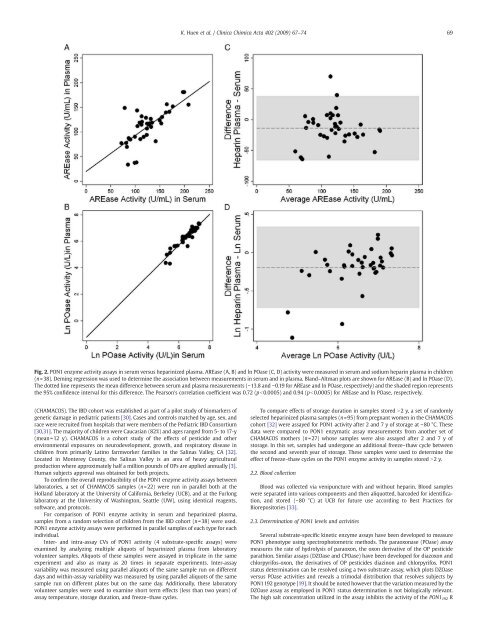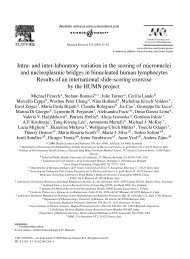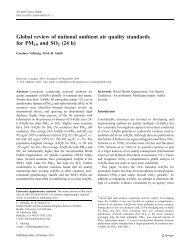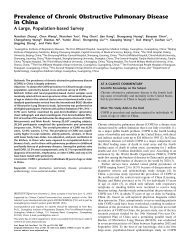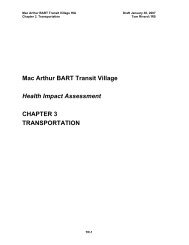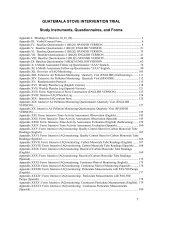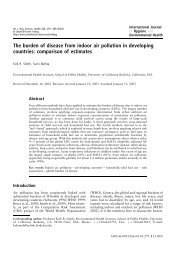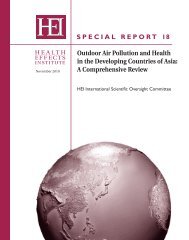Validation of PON1 enzyme activity assays for longitudinal studies
Validation of PON1 enzyme activity assays for longitudinal studies
Validation of PON1 enzyme activity assays for longitudinal studies
You also want an ePaper? Increase the reach of your titles
YUMPU automatically turns print PDFs into web optimized ePapers that Google loves.
K. Huen et al. / Clinica Chimica Acta 402 (2009) 67–7469Fig. 2. <strong>PON1</strong> <strong>enzyme</strong> <strong>activity</strong> <strong>assays</strong> in serum versus heparinized plasma. AREase (A, B) and ln POase (C, D) <strong>activity</strong> were measured in serum and sodium heparin plasma in children(n=38). Deming regression was used to determine the association between measurements in serum and in plasma. Bland–Altman plots are shown <strong>for</strong> AREase (B) and ln POase (D).The dotted line represents the mean difference between serum and plasma measurements (−13.8 and −0.19 <strong>for</strong> AREase and ln POase, respectively) and the shaded region representsthe 95% confidence interval <strong>for</strong> this difference. The Pearson's correlation coefficient was 0.72 (pb0.0005) and 0.94 (pb0.0005) <strong>for</strong> AREase and ln POase, respectively.(CHAMACOS). The IBD cohort was established as part <strong>of</strong> a pilot study <strong>of</strong> biomarkers <strong>of</strong>genetic damage in pediatric patients [30]. Cases and controls matched by age, sex, andrace were recruited from hospitals that were members <strong>of</strong> the Pediatric IBD Consortium[30,31]. The majority <strong>of</strong> children were Caucasian (82%) and ages ranged from 5- to 17-y(mean=12 y). CHAMACOS is a cohort study <strong>of</strong> the effects <strong>of</strong> pesticide and otherenvironmental exposures on neurodevelopment, growth, and respiratory disease inchildren from primarily Latino farmworker families in the Salinas Valley, CA [32].Located in Monterey County, the Salinas Valley is an area <strong>of</strong> heavy agriculturalproduction where approximately half a million pounds <strong>of</strong> OPs are applied annually [3].Human subjects approval was obtained <strong>for</strong> both projects.To confirm the overall reproducibility <strong>of</strong> the <strong>PON1</strong> <strong>enzyme</strong> <strong>activity</strong> <strong>assays</strong> betweenlaboratories, a set <strong>of</strong> CHAMACOS samples (n=22) were run in parallel both at theHolland laboratory at the University <strong>of</strong> Cali<strong>for</strong>nia, Berkeley (UCB), and at the Furlonglaboratory at the University <strong>of</strong> Washington, Seattle (UW), using identical reagents,s<strong>of</strong>tware, and protocols.For comparison <strong>of</strong> <strong>PON1</strong> <strong>enzyme</strong> <strong>activity</strong> in serum and heparinized plasma,samples from a random selection <strong>of</strong> children from the IBD cohort (n=38) were used.<strong>PON1</strong> <strong>enzyme</strong> <strong>activity</strong> <strong>assays</strong> were per<strong>for</strong>med in parallel samples <strong>of</strong> each type <strong>for</strong> eachindividual.Inter- and intra-assay CVs <strong>of</strong> <strong>PON1</strong> <strong>activity</strong> (4 substrate-specific <strong>assays</strong>) wereexamined by analyzing multiple aliquots <strong>of</strong> heparinized plasma from laboratoryvolunteer samples. Aliquots <strong>of</strong> these samples were assayed in triplicate in the sameexperiment and also as many as 20 times in separate experiments. Inter-assayvariability was measured using parallel aliquots <strong>of</strong> the same sample run on differentdays and within-assay variability was measured by using parallel aliquots <strong>of</strong> the samesample run on different plates but on the same day. Additionally, these laboratoryvolunteer samples were used to examine short term effects (less than two years) <strong>of</strong>assay temperature, storage duration, and freeze–thaw cycles.To compare effects <strong>of</strong> storage duration in samples stored N2 y, a set <strong>of</strong> randomlyselected heparinized plasma samples (n=95) from pregnant women in the CHAMACOScohort [32] were assayed <strong>for</strong> <strong>PON1</strong> <strong>activity</strong> after 2 and 7 y <strong>of</strong> storage at −80 °C. Thesedata were compared to <strong>PON1</strong> enzymatic assay measurements from another set <strong>of</strong>CHAMACOS mothers (n=27) whose samples were also assayed after 2 and 7 y <strong>of</strong>storage. In this set, samples had undergone an additional freeze–thaw cycle betweenthe second and seventh year <strong>of</strong> storage. These samples were used to determine theeffect <strong>of</strong> freeze–thaw cycles on the <strong>PON1</strong> <strong>enzyme</strong> <strong>activity</strong> in samples stored N2 y.2.2. Blood collectionBlood was collected via venipuncture with and without heparin. Blood sampleswere separated into various components and then aliquotted, barcoded <strong>for</strong> identification,and stored (−80 °C) at UCB <strong>for</strong> future use according to Best Practices <strong>for</strong>Biorepositories [33].2.3. Determination <strong>of</strong> <strong>PON1</strong> levels and activitiesSeveral substrate-specific kinetic <strong>enzyme</strong> <strong>assays</strong> have been developed to measure<strong>PON1</strong> phenotype using spectrophotometric methods. The paraoxonase (POase) assaymeasures the rate <strong>of</strong> hydrolysis <strong>of</strong> paraoxon, the oxon derivative <strong>of</strong> the OP pesticideparathion. Similar <strong>assays</strong> (DZOase and CPOase) have been developed <strong>for</strong> diazoxon andchlorpyrifos-oxon, the derivatives <strong>of</strong> OP pesticides diazinon and chlorpyrifos. <strong>PON1</strong>status determination can be resolved using a two substrate assay, which plots DZOaseversus POase activities and reveals a trimodal distribution that resolves subjects by<strong>PON1</strong>192 genotype [19]. It should be noted however that the variation measured by theDZOase assay as employed in <strong>PON1</strong> status determination is not biologically relevant.The high salt concentration utilized in the assay inhibits the <strong>activity</strong> <strong>of</strong> the <strong>PON1</strong> 192 R


